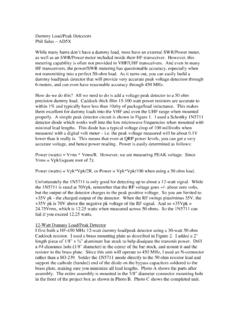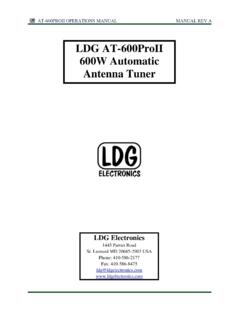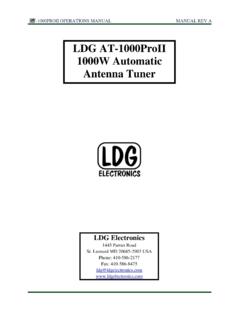Transcription of Review: The MFJ-994BRT and MFJ-998RT Remote Automatic ...
1 Review: The MFJ-994 BRT and MFJ-998RT Remote Automatic Antenna Tuners By Phil Salas AD5X Introduction I previously reviewed the MFJ-927, CG-3000 and SG-230 Remote auto-tuners specifically for use with a 43-foot vertical antenna (review is elsewhere on this website). At that time, the Remote tuners were limited to about 200 watts maximum RF power. Even the SGC SG-235 (which was not reviewed) is only capable of 200 watts CW, though it is rated at 500 watts SSB. This has all changed now with the introduction of the MFJ-994 BRT 600- watt and MFJ-998RT 1500- watt weatherproof Remote auto-tuners.
2 Figure 1: MFJ-998RT on the left, MFJ-994 BRT on the right. Remote tuner Application A Remote antenna tuner must be weatherproof, provide Automatic or semi- Automatic tuning, and it must be remotely powered. So for a given RF power handling and impedance matching equivalent, the Remote antenna tuner will be more expensive than a desk-top tuner . So since there are many manual and Automatic desk-top tuners available from numerous suppliers, why use a Remote antenna tuner ? The reason is that a Remote antenna tuner is an efficient way to match an antenna that has a high SWR and is fed through a relatively long length of coax cable.
3 This is because SWR-related coax cable losses can be high when the antenna SWR is high even if an in-shack tuner provides a 1:1 SWR for your equipment. You can easily demonstrate this with EZNEC simulations and any of the several on-line coax/SWR calculators. MFJ-994 BRT and MFJ-998RT High Power Autotuner Overview The MFJ-994 BRT and MFJ-998RT are Remote versions of the current MFJ-994B (600 watt ) and MFJ-998 (1500 watt ) switched-L desk-top auto-tuners (the MFJ-994, an earlier version of the MFJ-994B, was reviewed in the August 2006 QST). Turning these into Remote auto-tuners involved mounting them in weatherproof boxes and removing some of the desk-top features such as A/B antenna switching and multiple memory banks.
4 A comparison of the MFJ-994 BRT and MFJ-998RT auto-tuners is given in Table 1. Table 1: MFJ-994 BRT and MFJ-998RT Specifications MFJ-994 BRT MFJ-998RT Frequency Range MHz RF Power Capability 600 watts CW/SSB 1500 watts CW/SSB Resistive Matching Range 12-800 ohms 12-1600 ohms Input Capacitor Range 0-2950pf 0-3900pf Output Capacitor Range 0-2950pf 0-970pf Inductor Range 0-17uHy 0-24uHy 12-15 VDC current required 850ma max amps max Size (W/H/D approx) 14 3 10 in. 13 3 17 in. Weight lbs lbs Unique Features Besides RF power ratings, the MFJ-994 BRT and MFJ-998RT include some interesting features not found in other Remote auto-tuners.
5 The first is an internal BiasT for powering for those who may not have Remote DC power available. A MFJ-4117 BiasT is included with both auto-tuners for injecting DC onto the coax in your shack. The MFJ-4117 BiasT includes an on/off switch for convenient power control of the auto-tuners. The MFJ-994 BRT and MFJ-998RT provide both UHF and random wire outputs (only one can be used). The UHF connector has been hi-pot tested to over 2KV to ensure there is no possibility of arcing under high SWR conditions. These auto-tuners include an L/C limit feature which provides upper limits of inductance and capacitance according to frequency and maximum power rating which limits MFJ-994 BRT maximum peak voltage to 1000 volts and maximum peak current to 10 amps across these components.
6 For the MFJ-998RT the maximum limits are 2100 volts peak and 13 amps peak. So if a match could cause destructive voltages or currents, the auto-tuners will not permit the match. Both auto-tuners will not tune if more than 75 watts is applied and the SWR is greater than 3:1, or if more than 125 watts is applied regardless of SWR. This effectively locks the tuner settings when high power is applied. This protects both the tuner and an in-line amplifier from damage. Finally, both the MFJ-994 BRT and the MFJ-998RT can be remotely forced to re-tune on any given frequency with the Sticky TuneTM feature.
7 When Sticky TuneTM is enabled (default) these auto-tuners will always re-tune the first time you transmit after a power cycle. So if you want to try for a lower tuned SWR on a given frequency, simply cycle power and then transmit on that frequency. The MFJ-994 BRT and MFJ-998RT will re-tune and re-store the new tuning data for that frequency only. All other previously stored memory locations will be unaffected tuner Loss Measurements Resistive matching range and loss testing was performed with a precision set-up similar to that described in the February QST, 2003 (page 75) antenna tuner review.
8 A block diagram of my set-up is shown in Figure 2 below. The Array Solutions PowerMaster and the MiniCircuits PWR-6 GHS+ are both precision instruments with NIST-traceable calibration. I compared the PowerMaster to the PWR-6 GHS+/attenuator without the autotuner installed and verified that the readings were identical (the measurement difference was less than 1%). The high-power 6dB pad at the output of the IC-706 MKIIG helps stabilize the output power under varying load conditions, and ensures that any reflected power from a less than perfect auto- tuner match is attenuated 12dB further if re-reflected by the output circuitry of the transceiver.
9 To accurately measure the autotuner loss, the autotuner is inserted. After the autotuner has tuned at each SWR, the transceiver output level is adjusted so the PowerMaster reads exactly 10 watts (power display must be FWD-REFL). The resultant power is then read on the MiniCircuits PWR-6 GHS+ and compared to the computed lossless power. The SWR load box is shown in Figure 3 below. It utilizes 1% Caddock thick-film resistors to provide both high impedance and low impedance SWR loads. While close, some of the SWR selections are not even numbers as I used commonly available resistors.
10 IC-706 MKIIG ~40W output 6dB Attenuator SWR Load Box 40dB pad & MC PWR-6 GHS PowerMaster Coupler Autotuner Under test Figure 2: tuner Loss Measurement Set-up 50 100 330 150 50 750 25 15 S1 LO-Z SWR XMTR To 40dB pad and MinCircuits PWR-6 GHS :1 1:1 1:1 2:1 2:1 3:1 3:1 4:1 :1 :1 16:1 4 :1 Figure 3: SWR Resistive Load Box HI-Z SWR S2A S2B 33pf While resistive matching tests are great for standard antenna tuner comparison testing, Remote tuners will experience maximum inductance and highest RF current with short antennas so antenna tuner losses can be higher under these conditions.




